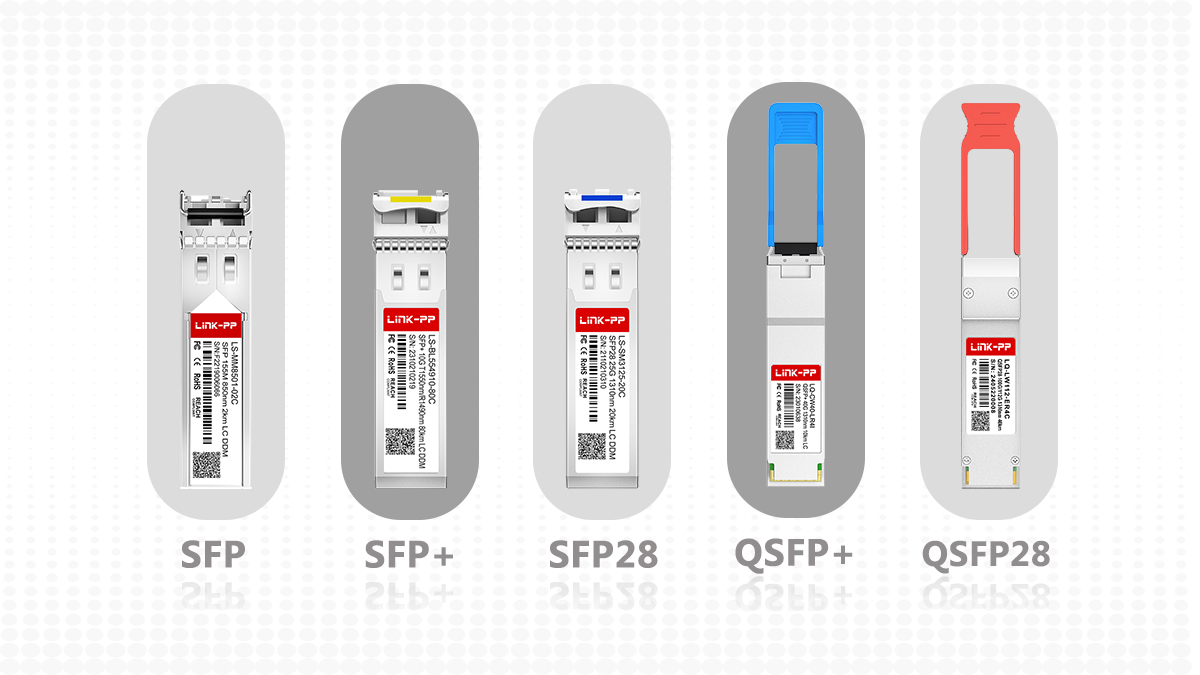
Optical modules are crucial for today’s communication systems as they convert electrical signals into light signals for rapid data transfer. Understanding their key parameters isn't just technical jargon – it's critical for ensuring compatibility, performance, and reliability in your data center, enterprise network, or telecom infrastructure. Choosing the wrong optical module specs can lead to costly downtime. This guide demystifies essential optical transceiver parameters and showcases how LINK-PP optical transceivers deliver optimized performance.
Why Optical Transceiver Parameters Matter
Every fiber optic transceiver is defined by a detailed set of specifications. These optical module parameters dictate:
Compatibility: Will it work with your switch, router, and cabling?
Performance: What data rate and distance can it achieve?
Reliability: Will it operate stably within your environmental conditions?
Cost-Effectiveness: Does it offer the right balance of features for your needs?
Key Optical Transceiver Parameter Categories
Let's break down the crucial optical transceiver specifications you need to evaluate:
1. Physical & Mechanical Specifications
Form Factor: The physical size and shape (e.g., SFP, SFP+, QSFP28, OSFP). Determines switch/port compatibility. 《Understanding the Different form factors of optical transceivers》
Connector Type: Interface to the fiber cable (e.g., LC Duplex, SC Duplex, MPO/MTP). Must match your patch cables.
2. Performance Specifications
Transmission Rate: The maximum speed the module supports (e.g., 1G, 10G, 25G, 100G, 400G). Critical for network bandwidth.
Wavelength: The color of light used (e.g., 850nm, 1310nm, 1550nm). Dictates fiber type (multimode/singlemode) and distance.
Fiber Type: Single Mode & Multi-mode Fiber included.
Transmission Distance: The achievable reach over specific fiber types (e.g., OM3, OM4, OS2). Multimode fiber distance is shorter than singlemode fiber reach.
Transmitter Type: Laser technology used (e.g., VCSEL for multimode, DFB/EML for singlemode). Impacts cost, power, and distance.
Receiver Type: Photodetector technology (e.g., PIN photodiode, APD). Affects sensitivity.
Transmitter Power (Tx Power): The output optical power level (measured in dBm). Must be within receiver's input range.
Receiver Sensitivity: The minimum optical power level the receiver needs to detect the signal correctly (measured in dBm). A lower (more negative) number indicates better sensitivity.
Power Budget: The difference between Tx Power and Receiver Sensitivity. Must be greater than the link loss (cable + connectors).
Receiver Saturation/Overload: The maximum optical power level the receiver can handle without distortion.
Extinction Ratio (ER): The ratio of power for a '1' bit to a '0' bit. A higher ratio improves signal quality.
Modulation Format: How data is encoded onto the light (e.g., NRZ, PAM4).
3. Monitoring & Management
DDM/DOM (Digital Diagnostics Monitoring): Real-time monitoring of parameters like Tx Power, Rx Power, Temperature, and Supply Voltage via the host device. Essential for proactive network maintenance.
4. Power & Environmental
Power Consumption: Crucial for data center power efficiency and thermal management.
Operating Temperature Range: Commercial (0°C to 70°C), Industrial (-40°C to 85°C), or Extended ranges.
5. Compliance & Standards
Protocols & Standards: Adherence to MSA (Multi-Source Agreement) specifications (e.g., SFF-8472 for DDM) and industry standards (e.g., IEEE 802.3ae for 10GBASE-SR) ensures interoperability.
Table 1: Core Optical Transceiver Parameter Overview
Parameter Category | Key Parameters | Importance |
|---|---|---|
Physical/Mechanical | Form Factor, Connector Type | Hardware compatibility, port fit |
Performance | Data Rate, Wavelength, Max Distance, Tx Power, Rx Sensitivity, Power Budget, Extinction Ratio, Modulation | Speed, reach, signal integrity, link reliability |
Monitoring | DDM/DOM Support | Real-time health monitoring, predictive maintenance |
Power/Environmental | Power Consumption, Operating Temperature Range | Energy efficiency, operational stability (data center, industrial settings) |
Compliance | MSA Standards, Protocol Support (e.g., IEEE) | Vendor interoperability, guaranteed performance |
Spotlight: LINK-PP 10G SFP+ SR Optical Transceiver - Key Parameters Explained
LINK-PP’s high-performance 10GBASE-SR SFP+ module exemplifies how optimized optical transceiver specs deliver robust, reliable connectivity for data center interconnects and enterprise networking. Let's dissect its parameters based on industry-standard specifications:
Table 2: LINK-PP LS-MM8510-S3C 10GBASE-SR SFP+ Transceiver Detailed Specifications
Parameter | Specification | Significance for Your Network |
|---|---|---|
Form Factor | SFP+ | Hot-pluggable, compatible with vast array of SFP+ switch/routers. High-density solution. |
Transmission Rate (Data Rate) | 10.3Gbps | Supports 10 Gigabit Ethernet, meeting core bandwidth demands. |
Wavelength | 850nm | Optimized for cost-effective multimode fiber (MMF) deployment. |
Transmission Distance (Cable Distance) | 300m (OM3 MMF), 400m (OM4 MMF) | Excellent reach for intra-rack and inter-rack connectivity within modern data centers. |
Connector | Duplex LC | Industry-standard, reliable, high-density connector. |
Fiber Type (Media) | MMF (Multimode Fiber) | Utilizes widely deployed OM3/OM4 fiber, lowering cabling costs. |
Transmitter Type | VCSEL (Vertical Cavity Surface Emitting Laser) | Low power consumption, high reliability, ideal for 850nm MMF applications. |
Receiver Type | PIN Photodiode | Cost-effective detector well-suited for the distances and power levels of 10GBASE-SR. |
Tx Power Range | -6dBm to 0.5dBm | Provides sufficient power to reach max distance without exceeding receiver overload limits. |
Receiver Sensitivity | < -10.5dBm | Highly sensitive receiver ensures reliable signal detection even after significant link loss. |
Power Budget | 3.8dB | Healthy margin accommodates typical connector and fiber losses over specified distances. |
Receiver Overload | 0.5dBm | Protects the receiver from damage by excessively strong incoming signals. |
Typical Power Consumption | ≤ 1W | Energy-efficient transceiver design reduces operating costs and thermal load. |
Extinction Ratio | > 3dB | Ensures clear distinction between signal bits (1s and 0s), reducing errors. |
DDM/DOM Support | Supported | Enables real-time monitoring of temperature, voltage, Tx/Rx power for health & diagnosis. |
Operating Temp Range | 0°C to +70°C (32°F to 158°F) | Suitable for standard commercial data center and enterprise environments. |
Fiber Core Size | 50/125µm | Standard for OM3/OM4 MMF, ensuring compatibility. |
Modulation | NRZ (Non-Return-to-Zero) | Standard modulation for 10G Ethernet. |
Compliance/Protocols | IEEE 802.3ae, SFF-8472, SFF-8431, SFF-8432,SFP+ MSA Compliant, CPRI, eCPRI | Guaranteed multi-vendor interoperability and support for telecom standards like CPRI. |
Warranty | 5 Years | Industry-leading warranty underscores LINK-PP's commitment to quality and reliability. |
Why Choose LINK-PP for Your Optical Transceiver Needs?

Understanding optical module parameters is the foundation, but selecting a trusted supplier is paramount. LINK-PP transceivers stand out by offering:
MSA Rigorous Compliance: Guaranteed interoperability with major OEM switches and routers.
Stringent Quality Control: Every LINK-PP SFP+ module undergoes comprehensive testing against published optical transceiver specifications.
Cost Efficiency: Delivering performance matching major brands at a significantly lower total cost of ownership (TCO).
Reliability & Longevity: Backed by a 5-year warranty and proven performance in demanding environments.
Comprehensive Support: Expert technical assistance for selecting the right 10G transceiver for your specific application.
Optimize Your Network with Confidence
Choosing the right optical transceiver is a critical network design decision. By mastering essential optical transceiver parameters – from form factor and data rate to wavelength, distance, DDM/DOM, and power specs – you empower yourself to build faster, more reliable, and cost-effective networks.
Ready to experience the LINK-PP difference in performance and value?
Have specific questions about optical module parameters or need help selecting the perfect transceiver? Contact our technical experts now!
FAQ
What does an optical module do in a network?
An optical module changes electrical signals into light signals. This helps devices in networks, like data centers, share data quickly. It makes sure data moves smoothly over short or long distances.
What affects how long an optical module lasts?
The lifespan depends on design, weather, and how it's used. High heat, moisture, or physical damage can shorten its life. Regular checks and care can make it last longer and work better.
How are single-mode and multi-mode fibers different?
Single-mode fibers send data far with little signal loss. Multi-mode fibers are cheaper and work well for short distances. Each type needs the right module to work properly.
What wavelengths are used in optical modules?
Common wavelengths are 850 nm, 1310 nm, and 1550 nm. Short wavelengths like 850 nm are good for short distances. Longer ones, like 1310 nm and 1550 nm, work better for long distances.
What should you think about when picking an optical module?
Look at speed, distance, wavelength, and fiber type. Also, check power use, temperature range, and reliability. Choosing the right features ensures your network works well.
See Also
Understanding TOSA's Role and Significance in Optical Modules
Exploring ROSA: The Receiver Optical Sub-Assembly Explained
WDM Explained: Key Applications in Optical Network Technology




